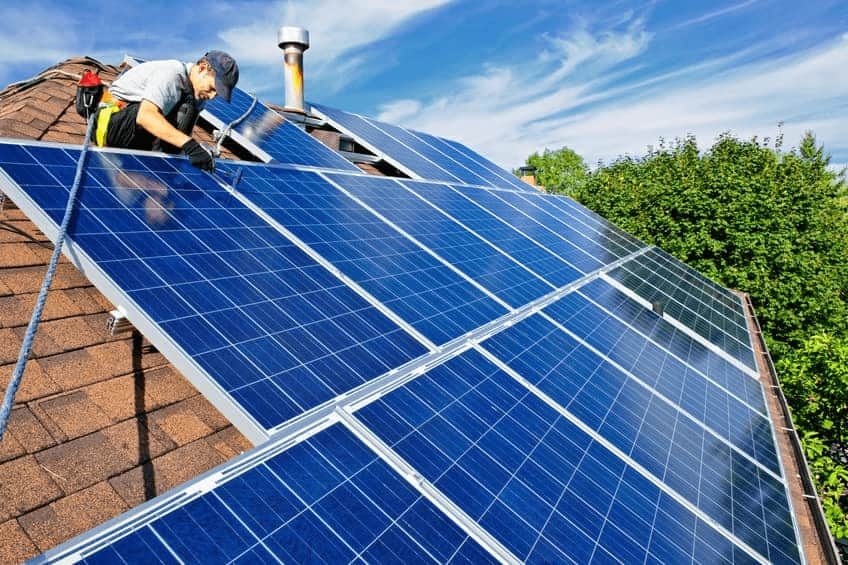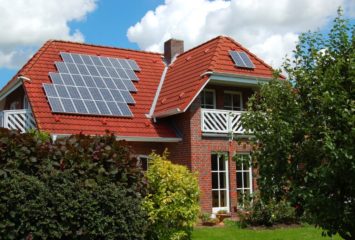50 Interesting Facts You Need to Know About Solar Energy
Our sun has been shining for over four and a half billion years. However, humans have only known about solar power since the 1830s, when Alexandre Edmond Becquerel discovered the photovoltaic effect. We don’t know why inventors always have such cool names, but we do know a slew of solar power facts—as it happens, we have 50 spotlighted below. Read on to learn about where in the world solar energy is the most popular, how solar energy impacts our health, how much solar panels cost, and much more.
Solar Energy Basics
- Solar power harnesses the natural energy of the sun to produce electricity. Specifically, solar cells capture certain wavelengths of solar radiation and convert them to electricity for our homes, calculators, and more.
- Photovoltaic cells in solar panels cause a reaction between photons and electrons on an atomic scale. When photons (light rays) collide with electrons, the electrons get catapulted loose. Then, the electrons are captured and channeled into usable electricity. Pretty neat, huh?
- Photovoltaic cells are commonly made from different types of silicon.
- Sunlight takes a little over eight minutes to reach Earth and a few seconds longer to make contact with your solar panels.
- In the United States, solar panels need to face south to capture optimal sunlight.
- Solar power is measured like all electricity—in watts (kilowatts, megawatts, gigawatts, and terawatts). One thousand watts equal one kilowatt, 1,000 kilowatts equal one megawatt, 1,000 megawatts equal one gigawatt, and 1,000 gigawatts equal one terawatt.
- Most solar panels have 200- or 250-watt capacities.
- The majority of solar panels can produce eight to ten kilowatts of energy per square foot.
- Most homes consume nearly 11,000 kilowatt-hours of energy each year, 1 meaning that to power your entire home off the grid, you’d need upwards of 30 250-watt solar panels that get a daily average of four hours of full sunlight.
- You can use solar power to run air conditioners, hot water heaters, and everything natural gas, electricity, or oil currently fuels. It’s the cheaper, safer, and more eco-friendly solution.
- When the sun isn’t shining, you can use a special battery as backup for your solar panel system. However, most modern solar units use net metering (a system hooked up to your city’s power grid that measures the difference between the energy you give back to the grid and the energy you use from the grid). For controlling energy deficits, net metering is an easier and cheaper method than storing excess solar energy in batteries.
- Solar panels don’t need direct sunlight to produce electricity. However, direct sunlight produces the most energy.
- Currently, the sun uses hydrogen for nuclear fusion. One day when all the hydrogen is gone, it will switch to helium—but that doesn’t matter for solar panels. They’ll continue to use the sun’s rays to create electricity to power our homes.
- In order to power the entire earth on renewable energy, we would need to install solar panels on over 191,000 square miles.2 Considering there are over 57million square miles of land on earth, we have room to spare.
Solar Energy and Health Facts
- Solar power is one of the cleanest, most sustainable, and most renewable resources in the world.
- Apart from the pollution given off during panel manufacturing, solar power produces no pollution, which is a by-product of non-renewable energy consumption and one of the biggest global killers.3 Pollution affects as many people as HIV or malaria and has serious effects on children, older adults, and all living plants and animals.
- Solar power does not create any noise pollution; solar panels silently create energy from the sun’s rays.
- Coal plants are the largest producers of carbon emissions, which contribute to global warming. Oil hurts the planet too. Each year in America alone, over one million gallons of petroleum spill into waterways, oceans, and groundwater. That’s why solar power is so important—it can reduce pollution and harm to the environment.
- A household rooftop solar panel system can reduce pollution by 100 tons of CO2 carbon dioxide in its lifetime—and this includes the energy it took to manufacture the solar panels.4 Solar panels can improve future air quality for humans as well as the millions of birds, fish, and mammals that are negatively affected by pollution each year.
Solar Power Cost and Affordability
- Fact: the cost of solar panels has dropped by 80% since 2008,5 and it is expected to keep falling.
- As of 2016, the average cost of solar energy alone was about $0.12 per kilowatt,6 which is fairly cheap compared to other energy sources.
- Solar cells are priced per watt. In 1977, solar cells were unaffordable for most to purchase and install—costing around $77 per watt!7
- Solar installation often ranges from $2.87 to $3.85 per watt. The entire installation package cost averages around $16,800, but if you apply tax credits, the total installation will probably sit between $10,045 and $13,475.8
- Solar power itself is a free source of energy. Once you’ve installed photovoltaic (PV) panels on your home, maintenance is minimal and returns are high.
- You don’t have to buy your solar panels outright; you can rent or finance This makes solar power more affordable for everyone.
- Most solar panels have a 25-year warranty, and if you rent or lease, most companies provide free maintenance.
- Many states allow you to sell the excess solar energy you produce, meaning you can not only earn back the cost of your panels but also make a profit on energy in the long run.
- Many states have incentive programs like rebates and coupons for solar panel installation. These programs are meant to encourage people to switch to more sustainable energy production. Policies vary by state, so find out what’s offered in yours when considering solar for your home.
- It takes the average homeowner six to fifteen years to pay off their solar panels;9 those living in sunnier climates or states with good incentive programs can do it in as little as two years.
- The average monthly electricity bill in America is about $110, as of 2013.10 Annually, we spend over $1,300 per household just on electricity. Depending on how much energy your solar panels produce (and how much you consume), your system could pay for itself—and your electricity bill—in a matter of years.
- Solar panels are exempt from property taxes in many states and can increase the value of a home more than a complete kitchen remodel. However, you can take your solar panels with you when you move.
- When you buy solar panels, you’re eligible for a 30% tax break from the federal government—you could get thousands of dollars back on your taxes and offset the initial cost.11
Solar Power Availability and Growth Facts
- Until the sun fizzles out, solar power will continue to be a very reliable energy source; our ability to harvest solar energy is solely dependent on technology, location, cost, and legislation.
- At the moment, the state is actually producing more solar energy than it has the infrastructure to consume.
- According to data from 2016, California generates the most solar power in America, followed by North Carolina, Arizona, Nevada, New Jersey, and Utah.12
- Las Vegas, Nevada is the biggest city in the country to operate on 100% renewable resources.
- Pollution can obscure the sun’s rays and stop light from reaching the Earth. Theoretically, the more humans who switch over to solar energy and reduce greenhouse gas emissions, the greater the Earth’s capacity to harness solar energy. It takes a village, right?
- Fact: Burlington, Vermont, was the first city in America to achieve 100% sustainable energy production for its people.
- As noted in 2016, more than 260,000 Americans currently work in the solar power industry.13 That number is expected to climb to more than 360,000 by 2021.14
- In 2016, there was one new solar panel installation every 84 seconds.
- NASA is presently working on a solar-powered aircraft.
- China has the most solar power wattage in the world—78,100 gigawatts—followed by Japan, Germany, the United States, and Italy.15
- Arizona and California are the sunniest states in America. No wonder they’re also leading producers and consumers of solar energy.
- Every square meter of our planet receives around 1,366 watts of direct solar radiation.16
Solar Power History
- The potential to harness solar power was first discovered by Alexandre Edmond Becquerel in 1839. He figured out the photovoltaic effect, or how to create an electrical current in a conductor that’s hit by the sun’s rays.
- The first commercial photovoltaic cell was invented in 1954 by Bell Laboratories.
- The first solar cells were available for purchase to the public in 1956, but at $300 per one-watt solar cell, few could afford them.
- The first solar-powered calculators were invented in 1978.
- In 2016, one company achieved 22.1% efficiency in converting sunlight to energy with their cadmium telluride panels.17
- Surprisingly, Exxon Mobile was one of the first companies to research ways to lower solar cell cost because the company used solar panels to power warning lights on oil rigs.
Solar power is an exciting, eco-friendly, and ever-expanding industry. Stay up to date on developments in solar news right here on SolarPowerAuthority.com!
Footnotes:
- S. Energy Information Administration, “Frequently Asked Questions”
- Business Insider, “Here’s how much of the world would need to be covered in solar panels to power Earth”
- org, “11 Facts About Pollution”
- The National Renewable Energy Laboratory, “PV FAQs”
- World Wildlife Fund, “Getting Solar is Easy”
- S. News, “When Will Rooftop Solar Be Cheaper Than the Grid?”
- Clean Technica, “13 Charts On Solar Panel Cost & Growth Trends”
- EnergySage, “How much do solar panels cost in the U.S.?”
- Energy Informative, “How Long to Pay Off my Solar Panels?”
- National Association of Home Builders, “Average Monthly Electrical Bill by State – Updated Data”
- Energy Informative, “How Long to Pay Off my Solar Panels?”
- Solar Energy Industries Association, “Top 10 Solar States”
- The Solar Foundation, “National Solar Jobs Census”
- Solar Energy Industries Association, “Solar Industry Data”
- International Energy Agency, “2016 Snapshot of Global Photovoltaic Markets”
- Conserve Energy Future, “Solar Energy Facts”
- MIT Technology Review, “First Solar’s Cells Break Efficiency Record”



3 Comments
This is an awesome post, thanks for sharing!
This is an amazing source of solar power information. Each point helps in understanding how one can save money and use the great resource of Sunlight and contribute to the global health and no pollution. Though there are cloudy days still this is an endless resource the human can utilize to protect the environment and keep it healthy for the next generation. Great post. Thank you and keep sharing the knowledge.
Wow! Thanks for providing such an interesting facts about solar energy as it is growing very fast and with this post people who are not aware of it will come to know about it. Solar panel should be used by everyone to make the environment eco-friendly.